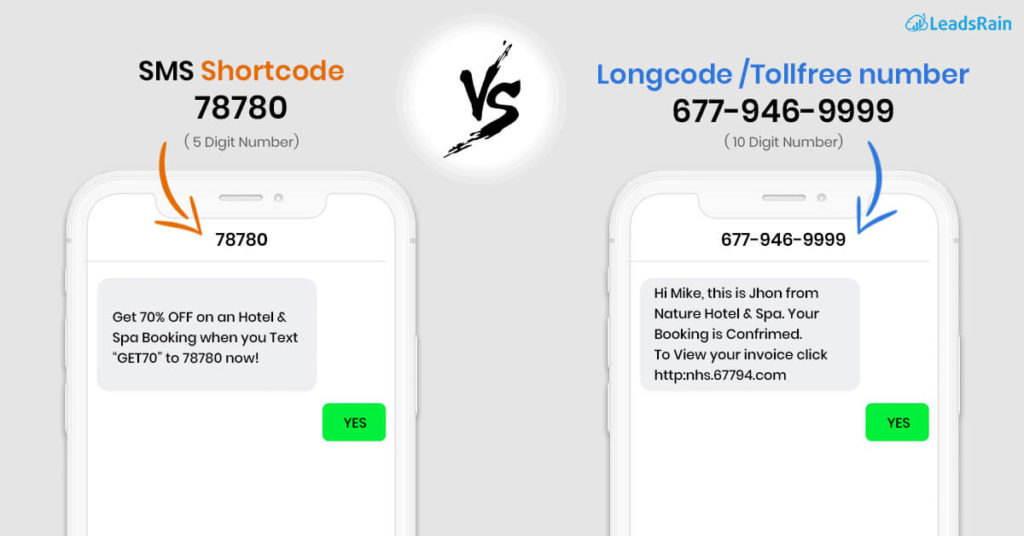The most cost-efficient, productive, and effective means to reach millions of customers across the globe is with the use of text messages or SMS marketing. According to tech jury statistics, text messages have a 209% higher response rate than a phone, email, or Facebook. Consumers open 98% of SMS received, compared to only 20% of emails. Nearly 30% of consumers respond to SMS marketing, of which 50% will make a purchase.
To develop a strategy for SMS marketing, one must decide between the use of an SMS short code, long code, or toll-free number. There is an appropriate time and circumstance for each of these marketing strategies. In order to select which primary form of SMS marketing to implement, you must first understand their differences.
What are SMS with Short Code?
Consumers receive an SMS short code from a five to six-digit number. In order to opt-in to future messages, the consumer is required to send a keyword back to the number from which they received the message.
There are two different types of SMS short codes to consider: Shared SMS short codes or Dedicated short codes.
Dedicated Short Codes
Dedicated short codes are numbers that apply specifically to one business. Many large corporations have acquired these dedicated SMS short codes in order to provide their business with exclusive keywords, brand security, and personalized brand recognition.
Shared short codes are ideal for many businesses, as they are less expensive than dedicated short codes, and equally effective in reaching consumers. Several businesses are capable of sharing the same short code, they are then simply assigned different keywords for consumers to respond and interact with the appropriate business.
Vanity vs Non-Vanity Short Codes
A vanity short code is a specific set of numbers personally selected by the business. Rather than a random set of numbers (non-vanity short code). Businesses often opt for vanity codes for the likelihood that consumers will remember the code.
When Should You Use SMS with Short Code?
SMS short codes are ideal in situations when bulk messages need to be sent in a timely manner. Examples of the use of SMS short codes include:
- Sales Alerts, Ads, Coupons, Other Promotions
- Alert Notifications
- Authentication
- Communication with Employees
With SMS short codes, businesses can send forty-sixty messages per second. These higher technological capabilities make SMS short codes the primary choice for large businesses due to their significantly faster messaging.
What is the SMS with Long Code?
SMS with a long code is a text message that is sent to consumers from a 10-digit phone number. Although it is inexpensive to use SMS long codes, these are much slower than SMS short codes, and are therefore not used for marketing purposes. There are also regulations with long code text messages in place that differ from SMS with short code. For example, inbound SMS vs outbound SMS should maintain a 1:3 ratio, otherwise, the carrier may block your SMS efforts.
When Should you use SMS with Long Code?
SMS with long code is not traditionally used for marketing intent, rather it is used for communication with consumers that have already purchased products or services. Examples of instances that SMS with long code should be used include:
- Transactional Messages
- Delivery Alerts
- Bank Notifications
- Airlines
- Other Customer Service Sector Information
What is SMS with Toll-Free Number?
SMS with a Toll-Free Number allows you to send mass messages or engage in one-on-one conversations with consumers. This will boost your marketing efforts and improve the experience for you and your customers. Numerous benefits include:
Convenience for Consumers- These calls are free for consumers.
Trackability- These calls provide information that will assist in business analytical needs. This includes information that will help the company advance, including when to run advertisements, changes needed and audience location.
Credibility- Whether used for marketing or customer service, toll-free numbers increase the positive business image, and promote company appearance.
A toll-free number shows consumers that your business is available to answer questions at their convenience.
Differences Between SMS Marketing Strategies
Aside from intent (marketing, customer service, etc.), there are other differences to consider each of these marketing strategies, including:
Capabilities- Short Codes possess much high technological capabilities as compared to long codes. Short codes are ideal for bulk messaging, whereas long codes are ideal for customer service uses. SMS with a toll-free number offers both capabilities.
Acquisition Process- A short code must be registered through the Us Common Short Code Administration and can take 6-8 weeks for approval. A long code, however, can be acquired much more quickly, available for use in as little as a day.
Security- With short codes and toll-free number SMS you are provided the confidence of knowing that your messages were received. Long codes can be blocked by carriers.
Typically, SMS short codes are used for the intent of marketing. Whereas SMS with long code is usually used for customer service purposes. Toll-free SMS offers the capabilities that both short and long SMS codes provide.
Rules of SMS Marketing
There are specific rules that one must abide by in order to use text messaging to reach consumers. When planning a marketing campaign, it is important to review and understand the rules set forth by the Federal Communications Commission (FFC), through the Telephone Consumer Protection Act, and how these laws will affect your SMS marketing campaign.
For example, consumers must opt-in to messaging, giving consent, in order for you to send SMS alerts. If the consumer does not give consent, hefty fines can result. Visit the Federal Communications Commission website to stay up to date on these ever-changing laws.
Contact for More Information
If you have questions regarding the different types of SMS strategies available, contact LeadRain today. We are standing by and ready to help you discover which option may be best for your company goals and vision. You can call us at 844-ON-CLOUD or chat with a live representative on our website.
